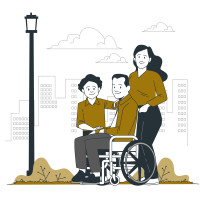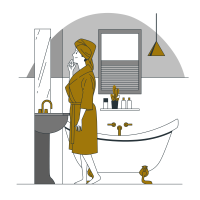The Roman Forum
 The Roman Forum - Rome
The Roman Forum - Rome
The Roman Forum, known in Latin as the Forum Romanum and by the Romans as the Forum Magnum or simply the Forum, is an archaeological site in Rome. It is located between the Palatine Hill, the Capitoline Hill, the Via dei Fori Imperiali and the Colosseum. The area contains layers of remains from different historical periods, and for much of ancient Rome's history it served as the political, legal, religious and economic heart of the city, as well as the focal point of the entire Roman civilisation.
From the royal age to the dawn of the Middle Ages, the Forum was the central setting for events and institutions of such significance that they repeatedly shaped the historical course of Western civilisation and exerted a considerable influence on the political, legal, cultural and philosophical foundations of Western thought.
After a period of decay beginning in Late Antiquity, the Forum underwent frequent plunderings and changes in function, leading to its almost complete burial in the 16th century, when it was converted into a pasture for cattle, earning the name Campo Vaccino (Cattle Field).
Driven by a revived and expanding interest in historical and archaeological research at the end of the 19th century, coupled with the extensive urban redevelopment that characterised post-unification and Fascist Italy, the Forum area was gradually uncovered and studied, eventually becoming one of the most famous and visited archaeological sites in the world, along with the Colosseum and the Palatine Hill.
The Roman Forum was the first archaeological site in the world to be excavated, and it is still one of the most important archaeological sites in the world.
 The Roman Forum - Rome
The Roman Forum - Rome
The Origins
From the 10th to the 7th century BC, the desolate marshy valley of the Forum served as a cemetery for the first villages to settle on the surrounding hills. As recorded by Tacitus, it was not only this vast plain that contained the Forum, but also the Capitoline Hill, which was joined together by Titus Tatius into what became known as the Romulus quadrilateral (Palatine Hill). Ancient writers, including Titus Livy, record that shortly after the founding of Rome, a great battle took place between the Romans and the Sabines on the site where the Forum was to be built: it is known as the Battle of Lake Curtius.
The main participants in this conflict were the vestal virgin Tarpeia, daughter of Spurio Tarpeio, who commanded a nearby Roman fortress. After being bribed with gold by Titto Tazio, she persuaded a group of armed men to enter her fortress on the Capitoline Hill. The Sabines took over this fortification and so both armies were able to assemble at the foot of two hills (the Palatine and the Capitoline, where the Roman Forum later stood). Both generals had time to organise for war: Mevio Curzio for the Sabines and Osto Ostilio for the Romans. Surrounded by mountains, their battlefield left no path for an army and no room to pursue a fleeing enemy. It was during this battle that Romulus, seeing his troops retreating, is said to have made a vow to Jupiter: if he were victorious, he would build him a temple on the site of what is now the Roman Forum.
Tradition has it that he threw himself into the middle of the battle and, by an extraordinary effort, turned the tide of the day in his favour, taking possession of the ruins of Rhegia as well as the Temple of Vesta. The first was built a few years later. Now the women - those Sabine women who had earlier been carried off by the Romans - rushed onto the field with spears against the enemy camp. She tried to divide the two sides and reduce their anger. This gesture led to a peace treaty, creating an inter-ethnic alliance that united two kingdoms while transferring decision-making power to Rome.
The lake near the Roman Forum is called Lake Curtius in honour of this battle and the Sabine commander Mevio Curzio, who narrowly escaped death. The Roman Empire was not fully constituted until around 600 BC. In the 4th century BC, during the reign of the Etruscan king Tarquinius Priscus, the valley was drained and the Cloaca Maxima was built and paved with tuff. It is this rectangular forum, at the heart of the city, that was considered both a marketplace and the centre of political and legal life. It crossed many important roads, the most important of which was the Via Sacra, which ran from the slopes of the Capitoline Hill to the Arch of Titus.
 The Roman Forum - Rome
The Roman Forum - Rome
Royal period
The Comitium is recognised as the oldest centre of political life, with archaic monuments dating back to the second half of the 6th century BC. They were placed in a room oriented to the cardinal points, inside the area paved with black stones known as Lapis niger, where, according to legend, Romulus died.
It was here that the oldest Latin inscription ever discovered was found and considered fundamental for understanding the steps of linguistic and literary evolution in Italy, despite the analyses of the Alatri linguist Luigi Ceci. On the western side of this Comitium, towards the slopes of the Campidoglio, near the so-called Umbilicus Urbis, stands the Volcanale, an ancient sanctuary, according to legend, built by Titus Tatius for the god Vulcan.
Since the 6th century the sacred functions of the Rex sacrorum and of the Pontifex Maximus took place here, with a curia called Hostilia - from Tullus Hostilius, according to tradition. There is also the circular temple of Vesta and several other large sanctuaries. However, what can be seen today is all that remains.
 The Roman Forum - Rome
The Roman Forum - Rome
Republican period
The beginning of the construction of the Temple of Saturn - which also housed the Treasury (the treasure of Rome) - and that of the Temple of the Castori in 484, which honoured the Dioscuri, Castor and Pollux, dates back to the early 5th century BC. In the same century, more precisely in 445, Lacus Curtius was consecrated by the consul Gaius Curtius Philones. In the 4th century BC, on the side facing the Capitoline Hill, the Temple of Concordia was built, in fulfilment of an agreement between the patricians and the plebeians.
The tribune of Comitia was adorned with a rostra decorated with the prows of ships taken from the fleet of the city of Antium. In 210 B.C., Titus Livius wrote that during the night edition of the Quinquatri festival, a fire broke out from various places around the Forum. At the same time, seven shops were burnt down; later, five new ones were built, including those of silversmiths. Some private buildings were involved in the conflagration, as there were no basilicas in the area at the time. The fish market and the prisons, as well as an atrium belonging to the Regia, also fell victim to the fire.
With great effort most parts of the temple of Vesta were saved, mainly by thirteen slaves who were immediately bought with public money and set free. This fire burned both day and night, as it was apparently deliberately lit in different places at the same time; therefore there is little doubt that it was arson. A new building fever in the 2nd century BC transformed the Forum. It was Sulla who began the transformation by building the Tabularium on the hill, which so beautifully regularised the background towards the Capitol.
Four basilicas for justice and business were built around the forum - Porcia, Emilia, Sempronia and Opimia. The Basilica Emilia still stands today, although it has been rebuilt many times, while Porcia and Sempronia were replaced by the Basilica Giulia, built by Caesar but completed under Augustus. Also under Caesar, the Curia Julia underwent a thorough reorientation; instead of maintaining its traditional ritual orientation to the cardinal points, it was oriented to the axes of the neighbouring Forum of Caesar. The tribune of the Rostra was also moved at the same time.
 The Roman Forum - Rome
The Roman Forum - Rome
The Age of Empire
Caesar began the final design of the Forum, which was completed in the time of Augustus. The square took on a more regular shape with the construction of two large basilicas - on its long sides, Emilia and Giulia - and with the Rostra now placed on the side of the square facing the Campidoglio. Now there is also a new temple dedicated to the Divine Julius, which Augustus consecrated in 29 BC, since Caesar had died and was only later deified. On that other shorter side of the Forum, towards the south-west, stood the Temple of Divine Julius, here also stood the Parthian Arch of Augustus and the portico of the Arch of Gaius and Lucius Caesar: thus these were taken away from so honoured Regia monumentum et templum Vestae. This decision is best seen within his ‘Caesarian’ phase of politics, coming before a later one characterised by more caution inspired by conservatism.
This new era of imperial development includes the rebuilding of the temples that Tiberius erected in 10 BC, apparently in an attempt to erase the memory of the recent civil wars, and also the monumental Castori, erected in 7 BC, associated with the brothers Tiberius and Drusus, drawing a link with the legendary siblings Dioscuri. The dedicatory inscription is located on one of the ends of the Basilica Emilia for Lucius Caesar, Augustus' son and presumed heir, dating from 2 AD; indeed, it was the porticoes in front of the basilica that were dedicated to both Lucius and his brother Gaius Caesar. Essentially, the renewed square was teeming with buildings linked to the Gens Iulia by name, symbolism or as the financier of their restoration. The Temple of Vespasian had its beginnings near the Temple of Concord; since then, another temple has been built outside the Forum proper, along the Via Sacra towards Velia - the Arch of Titus. It probably originated under Domitian. In the immediate vicinity, in front of the future Basilica of Maxentius, there are a few remains of the Horrea Vespasiani - warehouses ordered by the Emperor Vespasian.
The temple of Antoninus and Faustina, built in the 2nd century, was later incorporated into the church of San Lorenzo in Miranda. The Temple of Venus and Rome, built during Hadrian's reign, overlooks the valley where the Colosseum stands. In the early years of the third century, the arch of Septimius Severus was erected along the Via Sacra. During the reign of Diocletian, five columns on high masonry bases were added to the many monuments that probably filled the square at that time in honour of the Tetrarchy. In the 4th century the Basilica of Maxentius was begun and later completed under Constantine I.
During Maxentius' reign a circular entrance to the Temple of Peace, which had apparently fallen into disrepair, was adapted for use as a temple—the Temple of the Divine Romulus, dedicated to his son Valerius Romulus, who died young. After the defeat of the usurper Magnentius in 352, Praefectus urbi Nerazio Cereale had a statue erected in honour of the Emperor Constantius II (the base of which can still be seen today, next to the Arch of Septimius Severus towards the Curia). The Portico of the Consenting Gods, on the Campidoglio, was built during the Flavian period and restored in 367. It can be considered one of the most important monuments of late paganism, together with the last reconstruction of the Temple of Saturn.
 Medieval Period of Roman Forum
Medieval Period of Roman Forum
Medieval period
The north-eastern extension of the rostra was built in the fifth century. This part was rebuilt with very rough masonry and featured a rostra held in place by holes that are still visible. A one-line inscription states that it was the work of Giunio Valentino, praefectus urbi, during the reign of the emperors Leo I and Anthemius (around 470), for a naval victory over the Vandals, from whom the name Rostri vandalici derives.
After the fall of the city, the Forum lost its historical place; much of what remains today is due to the later Christian reuse of old pagan buildings, as in the case of the Basilica of Saints Cosmas and Damian, the oldest church found in the Forum. The tallest column in the Forum was dedicated to Phocas by the Senate of Rome in 608, in honour of the emperor. The Church of St Adrian in the Forum Romanum was also built here over the Curia Iulia in 630.
The last known public meeting in the Forum took place in 768 in front of the Church of Sant' Adriano, which played a key role in the papacy of Pope Stephen III. In the centuries that followed, there was a great and steady decay of the Forum due to neglect and abandonment, as well as a lot of material used for the construction of religious buildings. By the middle of the 12th century, access to the Forum had become almost impossible, as recorded in a document about processions and their routes.
An earlier version of what would later be called the Mirabilia Urbis Romae was also written at this time; although there were other innovations, this text remained the main written source for reconstructing not only the topography of the city but also its Forum for more than three hundred years. The Forum, which is mostly covered by earth, was used for grazing and farming to such an extent that it became known as 'Campo Vaccino' (Cattle Field).
 Roman Forum in the 1880
Roman Forum in the 1880
Modern period
But the greatest devastation came during the reign of Pope Julius II (1503-1513), when he decided to use the site entirely as a quarry, providing materials that could be reused, often after being turned into lime, for the architectural and artistic renovation plan he initiated for the city.
Eyewitnesses such as Pirro Ligorio have stated that the demolition of the monuments was very rapid; in some cases, structures that were almost intact could be demolished in no more than a month, and Raphael's protest and Michelangelo's concern were in vain. In the Temple of Antoninus and Faustina, as in many others threatened with total destruction, the marble slabs with which it had been decorated were removed, and traces of ropes used in attempts to pull down the columns can still be seen on their upper parts. In April 1536, it was decided that Charles V would make a triumphal entry into Rome, leading him and his entourage through the Roman Forum, then largely underground.
The exact route of the Via Sacra was not known at the time, so the route chosen for the procession - a straight line from the Arch of Titus to the Arch of Septimius Severus - bore no resemblance to the ancient route. Known today as Campo Vaccino, it was rediscovered by artists in the 16th century, who found in the ruins, at that time a meeting place and pasture, a highly distinctive subject much appreciated by painters of Roman landscapes. In the 17th and 18th centuries, however, the road was no longer used because the quarries were considered to have been exploited and the land was used mainly for grazing.
 Roman Forum Platner in the 1904
Roman Forum Platner in the 1904
The first scientific excavations in the area of the Roman Forum were begun in 1788 by the Swedish ambassador Carl Fredrik von Fredenheim, partly based on the work of the archaeologist and historian Johann Joachim Winckelmann. What they found was part of the Basilica Julia. More complete and systematic excavations were carried out here in 1801 by Carlo Fea, an archaeologist and art collector who was Commissioner of Antiquities in Rome for about thirty years, both during the Napoleonic period and then again with the restoration of the Papal Government. We owe him the excavation of the Pantheon.
The excavations brought to light large parts of the Forum, but they were not connected. Thus, the general plan to completely uncover the remains of the Forum as a whole was followed with more or less zeal by three successive administrations: first, the papal government; second, that of the Roman Republic; and third, that of the Kingdom of Italy, the last of which hastened the work of restoration in this area. Between 1870 and 1885, famous archaeologists such as Pietro Rosa, Giuseppe Fiorelli and Rodolfo Lanciani took part in the project.
The Minister Guido Baccelli also had a great role to play, because he allowed the removal of two roads that crossed the Forum, making it easier to turn it into a single archaeological park.
 Roman Forum in the 1880 - Consolazione Street
Roman Forum in the 1880 - Consolazione Street
Under the direction of Giacomo Boni, the excavations carried out between 1898 and 1904 led to the rediscovery of artefacts older than those previously discovered, most of which date from the classical imperial period. In particular, these excavations revealed the necropolis associated with the Temple of Antoninus Pius and Faustina, as well as the Lapis Niger.
In 1980, in order to restore the continuity of the route between the Forum and the Campidoglio, the section of Via della Consolazione within the Forum, between the slopes of the Campidoglio and the Temple of Saturn, was dismantled.
From 2010 to 2014, a series of stratigraphic and spatial studies were carried out in the area of the Forum between the Basilica Giulia and the Temple of Saturn, in order to investigate the route of the Vico Iugario. These studies revealed the first part of a staircase, indicating that the second floor of the Basilica was accessible to individuals, and also the remains of a dwelling dating from the 9th-10th century AD.
 Roman Forum Buildings
Roman Forum Buildings
Buildings and Monuments
List of buildings and monuments in the Forum Romanum that are still visible or no longer exist:
- Tabularium
- Basilica Emilia
- Sacellum of Venus Cloacina
- Temple of Janus
- Basilica Porcia
- Comitium
- Rostra
- Lapis Niger
- Curia
- Hostilia Curia
- Curia Iulia
- Bases of the Monuments of Honour in the Roman Forum
- Base of the Decennalia
- Arch of Septimius Severus
- Rostra
- Rostra
- Menia Column
- Rostra Column of Gaius Duilius
- Umbilicus Urbis
- Golden Milestone
- Volcanal
- Temple of Saturn
- Arch of Tiberius
- Portico of the Consenting Gods
- Temple of Vespasian and Titus
- Temple of Concord
- Basilica Opimia
- Tullian or Mamertine Prison
- Column of the Phocas
- Lacus Curtius
- Cavity of the equestrian statue of Domitian (Equus Domitiani)
- Basilica Giulia
- Temple of Augustus
- Temple of Castor
- Fountain of Giuturna of Giuturna
- Statio aquarum (aqueduct office)
- Oratory of the Forty Martyrs
- Group of Domitian's buildings in the Roman Forum
- Church of Santa Maria Antiqua
- Horrea Agrippiana
- Temple of Saint Julius
- Arch of Augustus
- Regia
- Arch of Gaius and Lucius Caesars
- Fabian Arch
- Temple of Vesta
- House of the Vestal Virgins
- Temple of Antoninus and Faustina
- Necropolis of the Temple of Antoninus Pius and Faustina (archaic necropolis)
- Republican "prison" (there is no evidence that it was a prison)
- Sacra Via Summa
- Temple of the Divine Romulus
- Medieval Portico
- Horrea Piperiana
- Basilica of Maxentius and Constantine
- Arch of Titus
- Temple of Venus and Rome
- Traces of a Republican house
- Forensic Antiquarium
- Cloaca Maxima (the first section ran through the area between the Basilica Emilia and the Basilica Giulia).
As we read in De verborum significatione by Sextus Pompeius Festus, a grammarian of the 2nd century AD, the Forum, which was also a marketplace, was served by running water channels, where the poor and homeless used to gather, and were therefore called 'i canalicoli forensi' (the forensic canals).
The Forum was also used as a marketplace.
 Temple of Saturn and Triumphal Arch of Septimus Severus between 1890 and 1900
Temple of Saturn and Triumphal Arch of Septimus Severus between 1890 and 1900
The Paving
The Roman Forum was probably paved in the early years of the Etruscan period, towards the end of the 7th century BC. The square was then re-paved several times during the Republican era - remains from this period have been found in various places. However, Professor Andrea Carandini, in all his years of excavation, has found a stratigraphy that goes back further than these layers and that shows that the first pavement of the Forum dates back to the 8th century BC (La Repubblica, 21.2.2005). The visible floor is dated around 12 BC by a large inscription, partially preserved because it has been restored, on the column of Phocas. Also preserved in relief in the Capitoline Museums, it refers to L. Naevius L. f . Surdinus pr., one of the mediators between the Romans and the foreigners of the time.
The inscription is in honour of this patron of pavers, as can be seen in other Roman colonies (e.g. Terracina, Sepino, Velleia). The fire took place in 12 BC - the Basilica Emilia burnt down together with most of the Forum (the side seat of the Basilica Giulia and the Temple of Vesta and the House of the Castori), so a new layout would have been necessary. Between Rostra and Lacus Curtius, there are some rather large pavements from the time of Caesar. There are also holes that show a system of tunnels that ran under the whole Forum from the same period.
During the excavations, wooden lifting devices were found; they are linked to the use of the Forum for gladiatorial shows in the Republican period. These holes were closed by Surdinus' pavement and it was at this point in history that the first permanent amphitheatre - called Statilius Taurus' bullring - was built on the Campus Martius. The Column of Phocas, was the last monument built in the Forum - it proves that the ground level was the same as in the Augustan period in 608 AD. In an unpaved square in front of the Rostra, there used to be the symbolic trees of figs, olives and vines.
They were placed there at a later date. It could also be that the statue of Marsyas, seen in the reliefs of Trajan in the Curia Iulia, was first placed here. Next to the inscription of Surdunus, on a lower level, there is a pavement of the Caesarean period, which in some places reveals an even older layer of tuff blocks. To the east, there is a dodecagon built in cappellaccio (friable tuff) with a circular base that has an opening in the centre that is thought to have been a well, probably that of Lacus Curtius.
Services and Accessibility

Wheelchair accessible

Toilets

Bookshop

Refreshment point

Baby Pit Stop

